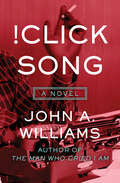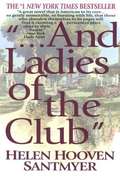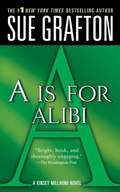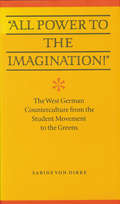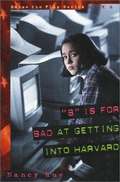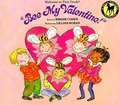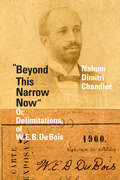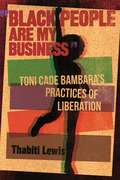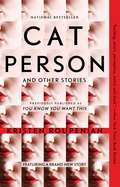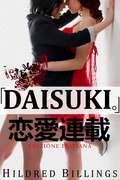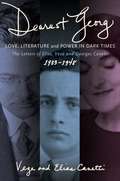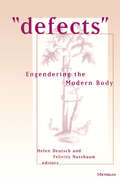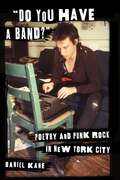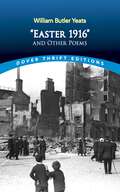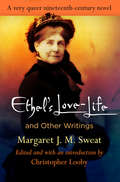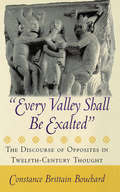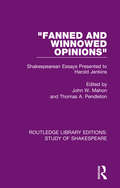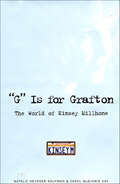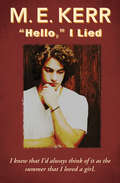- Table View
- List View
!Click Song: A Novel
by John A. WilliamsIn this fiercely authentic tale from the author of The Man Who Cried I Am, a gifted novelist confronts the powerfully entrenched, profit-motivated forces of corporate racism When his military service ends at the close of World War II—a period that will continue to haunt him throughout his life—Cato Douglass resolves to pursue a writing career and follows his dream to New York City. Soon, his first novel is published, and it appears his dream has been fulfilled, enabling him to travel the world, fall in love, marry, and start a family. But despite possessing a talent that shines brighter than that of many of his literary contemporaries, Cato discovers that he is trapped within a racist system. Only a handful of black writers receive the support of white editors and critics, and because Cato&’s work pushes the boundaries set by the publishing industry, he is doomed to a life of obscurity. The Chicago Sun-Times proclaimed !Click Song &“a major novel by one of America&’s finest living writers.&” Winner of the 1983 American Book Award, John A. Williams&’s enthralling chronicle of a writer&’s lifelong struggle to matter is a blistering tale of art, industry, family, and race.
"... And Ladies of the Club"
by Helen Hooven SantmyerSet in a small Ohio town and spanning 60 years, the books centers on the members of a book club and their struggles to understand themselves, each other, and their world.
"A" is for Alibi: A Kinsey Millhone Mystery (Kinsey Millhone Alphabet Mysteries #1)
by Sue GraftonREAD THE SENSATIONAL BLOCKBUSTER THAT STARTED IT ALL!Take it from the top in #1 New York Times bestselling author Sue Grafton's knockout thriller that introduced detective Kinsey Millhone—and a hot new attitude—to crime fiction…A IS FOR AVENGERA tough-talking former cop, private investigator Kinsey Millhone has set up a modest detective agency in a quiet corner of Santa Teresa, California. A twice-divorced loner with few personal possessions and fewer personal attachments, she's got a soft spot for underdogs and lost causes.A IS FOR ACCUSEDThat's why she draws desperate clients like Nikki Fife. Eight years ago, she was convicted of killing her philandering husband. Now she's out on parole and needs Kinsey's help to find the real killer. But after all this time, clearing Nikki's bad name won't be easy.A IS FOR ALIBIIf there's one thing that makes Kinsey Millhone feel alive, it's playing on the edge. When her investigation turns up a second corpse, more suspects, and a new reason to kill, Kinsey discovers that the edge is closer—and sharper—than she imagined."A" Is for Alibi"B" Is for Burglar"C" Is for Corpse"D" Is for Deadbeat"E" Is for Evidence"F" Is for Fugitive"G" Is for Gumshoe"H" Is for Homicide"I" Is for Innocent"J" Is for Judgment"K" Is for Killer"L" is for Lawless"M" Is for Malice"N" Is for Noose"O" Is for Outlaw"P" Is for Peril "Q" Is for Quarry"R" Is for Ricochet "S" Is for Silence "T" Is for Trespass"U" Is for Undertow "V" Is for Vengeance "W" Is for Wasted "X"
"All Power to the Imagination!": Art and Politics in the West German Counterculture from the Student Movement to the Greens (Modern German Culture And Literature Ser.)
by Sabine Von Dirke“All Power to the Imagination!” is a history of the counterculture’s immensely influential role in West German cultural and political life. Sabine von Dirke opens with an examination of nascent countercultural movements in West Germany during the 1950s. She then moves to a nuanced account of the student movement of the 1960s, describing its adaptation of the theories of Marcuse, Adorno, and Benjamin, then recounting its attack on “bourgeois” notions of the autonomy of art and culture. She next examines the subsequent development of a radical aesthetic and the effects of left-wing terrorism on Germany’s political climate. Later chapters focus on die tageszeitung, the ecology movement, and the rise of the Green Party. Von Dirke concludes by asking whether the evolution that this book traces—from Marxist-influenced critiques of culture and society to more diverse, less doctrinaire left-wing positions—represents progress or a betrayal of radical ideals. An ambitious study of the German left, this book is an important contribution to our understanding of postwar European history.
"And the Winner Is..." (Wondergirls #4)
by Jillian BrooksI'm going to run for class president. I know I have what it takes to Win! I really want to make a difference. And my Friends are excited to help. But planning my campaign is taking up a lot of time... and I'm getting some help From a new friend. I didn't mean to make anybody mad.... So why do I feel all alone? Reading level 4, Interest level ages 8-12
"B" Is for Bad at Getting into Harvard (Raise the Flag #2)
by Nancy RueA diverse group of high school girls faces the challenges of standing up for what they believe is right. You'll cheer them on and learn more about yourself in each book of the Raise the Flag series! One of the two editors-in-chief of the King High newspaper, Norie runs with the "high achiever" crowd: kids who participate in things like the Academic Olympics...and cheating rings. As a Christian who has recently rededicated her life to God, Norie doesn't want to be a part of it. But stress builds as her friends pressure her to help them. Even worse, Norie's dad wants her to study more instead of spending time with her prayer partners, the Flagpole Girls. He desperately wants her to get into Harvard. But with the change in the grade curve, that'll never happen unless Norie starts cheating, too. Now if she's going to resist the temptation--and avoid being framed by the very kids she's trying to stop--she's going to need prayer, and her Christian friends, more than ever before.
"Bee My Valentine!"
by Miriam Cohen[from the back cover] "It's Valentine's Day in First Grade. All the children send cards to each other. Everyone is excited. Some people get lots of cards--but some people don't. And there are tears. But Jim knows how to make George feel better--and all the others join in. By the time the refreshments arrive, it is indeed a Happy Valentine's Day for everyone in First Grade."
"Beyond This Narrow Now": Or, Delimitations, of W. E. B. Du Bois
by Nahum Dimitri ChandlerIn “Beyond This Narrow Now” Nahum Dimitri Chandler shows that the premises of W. E. B. Du Bois's thinking at the turn of the twentieth century stand as fundamental references for the whole itinerary of his thought. Opening with a distinct approach to the legacy of Du Bois, Chandler proceeds through a series of close readings of Du Bois's early essays, previously unpublished or seldom studied, with discrete annotations of The Souls of Black Folk: Essays and Sketches of 1903, elucidating and elaborating basic epistemological terms of his thought. With theoretical attention to how the African American stands as an example of possibility for Du Bois and renders problematic traditional ontological thought, Chandler also proposes that Du Bois's most well-known phrase—“the problem of the color line”—sustains more conceptual depth than has yet been understood, with pertinence for our accounts of modern systems of enslavement and imperial colonialism and the incipient moments of modern capitalization. Chandler's work exemplifies a more profound engagement with Du Bois, demonstrating that he must be re-read, appreciated, and studied anew as a philosophical writer and thinker contemporary to our time.
"Black People Are My Business": Toni Cade Bambara's Practices of Liberation (African American Life Series)
by Thabiti Lewis"Black People Are My Business": Toni Cade Bambara’s Practices of Liberation studies the works of Bambara (1939–1995), an author, documentary filmmaker, social activist, and professor. Thabiti Lewis’s analysis serves as a cultural biography, examining the liberation impulses in Bambara’s writing, which is concerned with practices that advance the material value of the African American experience and exploring the introspection between artist production and social justice. This is the first monograph that focuses on Bambara’s unique approach and important literary contribution to 1970s and 1980s African American literature. It explores her unique nationalist, feminist, Marxist, and spiritualist ethos, which cleared space for many innovations found in black women’s fiction. Divided into five chapters, Lewis’s study relies on Bambara’s voice (from interviews and essays) to craft a "spiritual wholeness aesthetic"—a set of principles that comes out of her practices of liberation and entail family, faith, feeling, and freedom—that reveals her ability to interweave ethnic identity, politics, and community engagement and responsibility with the impetus of balancing black male and female identity influences and interactions within and outside the community. One key feature of Bambara’s work is the concentration on women as cultural workers whereby her notion of spiritual wholeness upends what has become a scholarly distinction between feminism and black nationalism. Bambara’s fiction situates her as a pivotal voice within the Black Arts Movement and contemporary African American literature. Bambara is an understudied and important artistic voice whose aversion to playing it safe both personified and challenged the boundaries of black nationalism and feminism. "Black People Are My Business" is a wonderful addition to any reader’s list, especially those interested in African American literary and cultural studies.
"C" Is for Cupcake
by Carolyn HaywoodThe first grade taught by Mrs. Wilkins in this book is an exciting place. Mrs. Wilkins is a teacher who is game for any activity that her pupils suggest, and Carolyn Haywood is just the writer to make sure that she never remains unchallenged for long. Most of the escapades concern Christie's pet rabbit named Cupcake, but further complications abound. Christie first takes Cupcake to school when the rest of the class is bringing baked goods to sell on Cupcake Day. Despite the confusion, the white rabbit quickly becomes the unofficial mascot of the room. Other animals also enter Mrs. Wilkins's life. At various times she must cope with a Siamese cat on the rampage and a Belgian rabbit named Cinnamon Bun. The climax comes, however, when baby rabbits arrive during breakfast at which the first graders are entertaining their daddies. First grade today is made for the irrepressible children created by Carolyn Haywood. Warm and funny, her story of their year's doings captures the spirit of the modern school.
"Cat Person" and Other Stories: Cat Person And Other Stories
by Kristen Roupenian*Includes the story &“Cat Person&”—now a major film* A compulsively readable collection of short stories that explore the complex—and often darkly funny—connections between gender, sex, and power across genres. &“These stories are sharp and perverse, dark and bizarre, unrelenting and utterly bananas. I love them so, so much.&” —Carmen Maria Machado, National Book Award Finalist and author of Her Body and Other Parties &“Kristen Roupenian isn&’t just an uncannily great writer, she also knows things about the human psyche…The world has made a lot more sense since reading this book.&” —Miranda July, New York Times bestselling authorPreviously published as You Know You Want This, &“Cat Person&” and Other Stories brilliantly explores the ways in which women are horrifying as much as it captures the horrors that are done to them. Among its pages are a couple who becomes obsessed with their friend hearing them have sex, then seeing them have sex…until they can&’t have sex without him; a ten-year-old whose birthday party takes a sinister turn when she wishes for &“something mean&”; a woman who finds a book of spells half hidden at the library and summons her heart&’s desire: a nameless, naked man; and a self-proclaimed &“biter&” who dreams of sneaking up behind and sinking her teeth into a green-eyed, long-haired, pink-cheeked coworker. Spanning a range of genres and topics—from the mundane to the murderous and supernatural—these are stories about sex and punishment, guilt and anger, the pleasure and terror of inflicting and experiencing pain. These stories fascinate and repel, revolt and arouse, scare and delight in equal measure. And, as a collection, they point a finger at you, daring you to feel uncomfortable—or worse, understood—as if to say, &“You want this, right? You know you want this.&”
"DAISUKI." (Edizione Italiana)
by Hildred Billings Laura CarlettiLa serie REN'AI RENSAI offre uno sguardo su una relazione lesbica lungo il corso di decenni, raccontandola in ordine non cronologico tramite romanzi, romanzi brevi, novelle e racconti. "DAISUKI." Aiko e Reina stanno assieme da quasi vent'anni, ma c'è sempre stato un qualcosa di non detto tra loro: daisuki, ossia "ti amo." Con l'avvicinarsi dell'anniversario, la loro relazione giunge a un punto morto perché Aiko, la casalinga giapponese, inizia a chiedere non solo dei "ti amo," ma anche un matrimonio e del romanticismo. Reina però non capisce concetti complessi come "amore" o altre emozioni. Per anni ha supportato finanziariamente la compagna con un lavoro che le succhia l'anima, e si è presa cura dei loro reciproci bisogni in camera da letto. Non basta? In una cultura che le chiede di scegliere tra il mondo "femminile" e quello "maschile," ha già abbastanza difficoltà a trovare il suo ruolo senza che Aiko le faccia pressioni. Certe parole non hanno bisogno di essere pronunciate, ma un "ti amo" potrebbe distruggere una relazione che già si barcamena tra incursioni di terzi e altri episodi bizzarri. "DAISUKI." si svolge tra dicembre 2011 e luglio 2012 NOTA - contiene: *Linguaggio esplicito *Scene di sesso *Poliamore/relazioni aperte *Disforia di genere *Tanto amore per donne che amano donne Riservato a un pubblico maturo
"DAWGS!": An Anthology of Stories About Them
by Charles Wright GrayShort story collection by famous authors such as D. H. Lawrence, Booth Tarkington, O. Henry, Albert Payson Terhune, Don Marquis and Max Brand, as well as less well-known. Stories show their times with some being violent and Definitely Not pc. Not for the tender hearted with the exception of 4 or so.
"DOG Gone Christmas": A Cozy Little Murder Mystery
by Terry I. MilesSeven years ago the housekeeper, Maudelle Perkins, found Horace Fletcher, Director of Shady Rest Funeral Home, dead at his desk. Cyrus Dedeaux, one of three morticians hired by Mr. and Mrs. Fletcher, was declared guilty. However, new DNA evidence, presented by his lawyer, had proven Mr. Dedeaux innocent and he has been set free! Three days after Cyrus returned, there has been an alleged attempted murder on Rose Fletcher, Horace's widow, and a body has washed up on the beach. Before attending the gala benefit honoring environmentalist, Dr. Horatio Banks, in Bay St. Louis, Mississippi, Mrs. Julia McKenna and her boyfriend, Captain Eric VonBoatner, are supposed to pick up a 1927 Model T. Ford, which she won two months earlier in a drawing. During an impromptu shopping spree, Aunt Jewels and a dog named Maggie May are kidnapped and dog napped respectively. Upon inspection of the floorboards inside of the antique car, her niece, Private Investigator Bea Winslow, discovers small specks of dried blood. Mystery, mayhem and merriment, follow these two sleuths as they weave their humor, crime solving tactics and hilarious antics, through a host of unsavory characters, the funeral parlor, saving the environment, Christmas festivities in the Bay and finding Aunt Jewels and Maggie May.
"Dearest Georg": Love, Literature, and Power in Dark Times
by David Dollenmayer Karen Lauer Vesa CanettiIn 1934, Veza Taubner and Elias Canetti were married in Vienna. Elias describes the arrangement to his brother Georges as a "functional" marriage. Meanwhile, an intense intellectual love affair develops between Veza and Georges, a young doctor suffering fromtuberculosis. Four years later, Veza and Elias flee Nazi-ruled Vienna to London, where they lead an impoverished and extremely complicated marital life in exile. Spanning the major part of Elias's struggle for literary recognition, from 1933, before the publication of his novel, Auto-da-Fé, to 1959, when he finished his monumental Crowds and Power, the Canetti letters provide an intimate look at these formative years through the prism of a veritable love triangle: the newly married Elias has a string of lovers; his wife, Veza, is hopelessly in love with an idealized image of his youngest brother, Georges; and Georges is drawn to good looking men as well as to his motherly sister-in-law. Independently and often secretly, the couple communicates with Georges, who lives in Paris: Veza tells of Elias's amorous escapades and bouts of madness, Elias complains about Veza's poor nerves and depression. Each of them worries about Georges's health-if she could, Veza would kiss away the germs. Georges is an infrequent correspondent, but he diligently stores away the letters from his brother and sister-in-law. In 2003, long after his death, they were accidentally discovered in a Paris basement and comprise not only a moving and insightful document, but real literature.From the Hardcover edition.
"Defects": Engendering the Modern Body (Corporealities: Discourses Of Disability)
by Felicity Nussbaum Helen Deutsch"Defects" brings together essays on the emergence of the concept of monstrosity in the eighteenth century and the ways it paralleled the emergence of notions of sexual difference. Women, declared a mid-eighteenth-century vindication, have been regarded since Aristotle as deformed amphibious things, "neither more or less than Monsters" (Beauty's Triumph 1758). This alliance of monstrosity with misogyny, along with the definition of sexual difference as aberration, is the starting point for this volume's investigation of monstrosity's cultural work in the eighteenth century and its simultaneous mapping and troubling of the range of differences. This collection investigates the conceptual and geographical mapping of early modern and Enlightenment ideas of monstrosity onto a range of differences that contested established categories. The essays consider the representations and material dimensions of phenomena as diverse as femininity and disfigurement, the material imagination and monstrous birth, ugliness as an aesthetic category, deafness and theories of sign language, and the exotic, racialized deformed. Collectively, they demonstrate that the emergence of sexual difference is inextricably intertwined with the emergence of a category of the human that is imagined and deformed, monstrous, and ugly. Contributors include Barbara Benedict, Jill Campbell, Elizabeth Heckendorn Cook, Lennard Davis, Helen Deutsch, Robert Jones, Cora Kaplan, Nicholas Mirzoeff, Felicity Nussbaum, Stephen Pender, and Joel Reed.
"Do You Have a Band?": Poetry and Punk Rock in New York City
by Daniel KaneDuring the late 1960s, throughout the 1970s, and into the 1980s, New York City poets and musicians played together, published each other, and inspired one another to create groundbreaking art. In "Do You Have a Band?", Daniel Kane reads deeply across poetry and punk music to capture this compelling exchange and its challenge to the status of the visionary artist, the cultural capital of poetry, and the lines dividing sung lyric from page-bound poem.Kane reveals how the new sounds of proto-punk and punk music found their way into the poetry of the 1960s and 1970s downtown scene, enabling writers to develop fresh ideas for their own poetics and performance styles. Likewise, groups like The Fugs and the Velvet Underground drew on writers as varied as William Blake and Delmore Schwartz for their lyrics. Drawing on a range of archival materials and oral interviews, Kane also shows how and why punk musicians drew on and resisted French Symbolist writing, the vatic resonance of the Beat chant, and, most surprisingly and complexly, the New York Schools of poetry. In bringing together the music and writing of Richard Hell, Patti Smith, and Jim Carroll with readings of poetry by Anne Waldman, Eileen Myles, Ted Berrigan, John Giorno, and Dennis Cooper, Kane provides a fascinating history of this crucial period in postwar American culture and the cultural life of New York City.
"Easter 1916" and Other Poems
by William Butler Yeats"A terrible beauty is born," observed the greatest modern Irish poet after his country's 1961 Easter Rebellion against the British. This streak of proud nationalism, interwoven with elements of Celtic lore and mysticism, and infused with a hard-earned wisdom, makes Yeats's work resonate to this day. His career spanned five decades, earning him the Nobel Prize in Literature in 1923, and he is widely regarded as the finest English-language poet of the twentieth century.This volume contains a rich selection of poems from Yeats's mature work, including all the poems from The Wild Swans at Coole (1919) and Michael Robartes and the Dancer (1921). These memorable verses, embodying subtlety and objectivity in language of stark beauty and simplicity, offer a cross-section of Yeats's multifaceted poetic production.In addition to the famous title poem, the works collected here include the oft-quoted "The Second Coming" as well as "An Irish Airman Foresees His Death," "The Wild Swans at Coole," "In Memory of Major Robert Gregory," "Under the Round Tower," "Michael Robartes and the Dancer," "The Rose Tree," "A Prayer for My Daughter," "A Meditation in Time of War," and many more.
"Ethel's Love-Life" and Other Writings (Q19: The Queer American Nineteenth Century)
by Margaret J. SweatIn a series of lengthy letters, the unsettled and unruly Ethel Sutherland writes to an initially unnamed and ungendered correspondent, and patiently discloses the troubled history of her past romantic attachments to both men and women. Not until the third letter does she reveal that her correspondent is Ernest, the man to whom she is engaged to be married. Wanting to make him understand how all of her past loves are included and sublimated in her love for him, she especially wants to explain how "women often love each other with as much fervor and excitement as they do men"; and although this love is curiously "freed from all the grosser elements of passion, as it exists between sexes," nevertheless it "retains its energy, its abandonment, its flush, its eagerness, its palpitation, and its rapture."Margaret Jane Mussey Sweat (1823-1908), a native of Portland, Maine, and wife of a United States congressman, published Ethel's Love-Life in 1859. The book is sometimes credited as an early—even the first—"lesbian" American novel, but such a label, Christopher Looby observes in his Introduction, somewhat misrepresents what is distinctive and surprising about the book. Ethel's Love-Life confounds our received binary distinctions between the spiritual and the carnal and, indeed, between the sexual and the nonsexual—the boundaries between such categories being not nearly as well-policed at the time as they later became. It is here reprinted, along with Sweat's Verses (1890) and five of her published essays, on Charlotte Brontë, George Sand, the contemporary novel, and the friendships of women.
"Every Valley Shall Be Exalted": The Discourse of Opposites in Twelfth-Century Thought
by Constance Brittain BouchardIn high medieval France, men and women saw the world around them as the product of tensions between opposites. Imbued with a Christian culture in which a penniless preacher was also the King of Kings and the last were expected to be first, twelfth-century thinkers brought order to their lives through the creation of opposing categories. In a highly original work, Constance Brittain Bouchard examines this poorly understood component of twelfth-century thought, one responsible, in her view, for the fundamental strangeness of that culture to modern thinking.Scholars have long recognized that dialectical reasoning was the basic approach to philosophical, legal, and theological matters in the high Middle Ages. Bouchard argues that this way of thinking and categorizing—which she terms a "discourse of opposites"—permeated all aspects of medieval thought. She rejects suggestions that it was the result of imprecision, and provides evidence that people of that era sought not to reconcile opposing categories but rather to maintain them.Bouchard scrutinizes the medieval use of opposites in five broad areas: scholasticism, romance, legal disputes, conversion, and the construction of gender. Drawing on research in a series of previously unedited charters and the earliest glossa manuscripts, she demonstrates that this method of constructing reality was a constitutive element of the thought of the period.
"Fanned and Winnowed Opinions": Shakespearean Essays Presented to Harold Jenkins (Routledge Library Editions: Study of Shakespeare)
by John W. Mahon and Thomas A. PendletonOriginally published in 1987, "Fanned and Winnowed Opinions" celebrates the scholarship of Professor Harold Jenkins, one of this century’s foremost editors and critics of Shakespeare. All of the essays address Shakespearean topics, and many of the sixteen focus on the years between 1595 and 1605, the period on which much of Professor Jenkin’s work centers: there are, appropriately, three essays on Hamlet. A variety of critical approaches is represented, including the Freudian and the feminist; some essays focus on one play, while others take a thematic approach. Comedies, histories, and tragedies all come under consideration. The contributors include many distinguished scholars, some of whom studied under Professor Jenkins or edited volumes of the Arden Shakespeare under his direction. All of the contributions were specifically written for the Festschrift and had not appeared in print before. In addition to the scholarly essays, the volume features an introduction with an appreciative review of Harold Jenkins’ career and a complete bibliography of his works.
"G" Is for Grafton: The World of Kinsey Millhone
by Natalie Hevener Kaufman Carol Mcginnis KayIn this well cited and extraordinarily researched revised edition, the authors have collected every fact about America's favorite female sleuth, Kinsey Millhone. Collaborating and consulting with Sue Grafton, the author of the Kinsey Millhone alphabet mysteries and the creator of Kinsey, the authors give Kinsey fans a notable reference for that once mentioned fact they're just dying to know. In which book was a hit man after Kinsey? What does Kinsey think of killing? Who are Kinsey's friends? What does Kinsey laugh at? Where did Kinsey receive her P.I. training? The answers to these questions and hundreds more await readers of "G" Is for Grafton. The book also includes a chapter on Grafton's writing style and Grafton's thoughts on Kinsey. Updated through "O" Is for Outlaw.
"G" is for Grafton: The World of Kinsey Millhone
by Natalie Hevener Kaufman Carol McGinnis KayRevised and updated through "O" Is for Outlaw, the Edgar Award Winner for Best Biographical Work is the essential reader's companion to the world of Sue Grafton's Kinsey MillhoneWith the cooperation of Sue Grafton, who provided unprecedented access to her working journals, authors Natalie Hevener Kaufman and Carol McGinnis Kay have created a fully dimensional biography of Kinsey Millhone that will answer every question readers have ever had. Here is a feast for Kinsey's fans, including such features as time lines, maps, floor plans, case logs, and photographs.But this book is also a revealing journey into the mind and work habits of Kinsey's creator. You'll learn why Grafton chose to write detective fiction and how she responds to runaway plot lines and unruly characters. You will find out what titles she has discarded in the series, what she plans for Kinsey's future, and how she sees their evolving relationship. Ultimately, you'll understand why Grafton is so esteemed in the field of detective fiction and, from an analysis of her craft, why she has earned so prominent a place in American letters.
"Hello," I Lied
by M. E. KerrSummering in the Hamptons on the estate of a famous rock star, seventeen-year-old Lang tries to decide how to tell his longtime friends that he is gay, while struggling with an unexpected infatuation with a girl from France.
"Hello," I Lied
by M. E. KerrFrom the Margaret A. Edwards Award–winning author of Deliver Us from Evie comes a novel about a gay teenager who discovers a different kind of love during an unforgettable summer in the HamptonsI&’d always think of it as the summer that I loved a girl . . .Seventeen-year-old Lang Penner and his mother are spending the summer in the caretaker&’s cottage at Roundelay, the sprawling East Hampton estate of legendary rocker Ben Nevada. Lang passes the time walking on the beach and hoping for a glimpse of his idol. When they finally meet, Nevada is very different from the man Lang imagined. He finds himself confiding in the retired star about his homosexuality. When Nevada hears Lang&’s secret, he figures Lang is a safe bet to show the seventeen-year-old daughter of some friends from France a good time in the Hamptons. This was supposed to be the summer of Lang&’s coming out. He even has a boyfriend, Alex, a twenty-year-old actor living in Manhattan. The last thing he expects is to become infatuated with a girl.&“Hello,&” I Lied is a story about all kinds of love—from friendship to physical attraction to hero worship—as a teenager bravely confronts his sexuality. This ebook features an illustrated personal history of M. E. Kerr including rare images from the author&’s collection.
